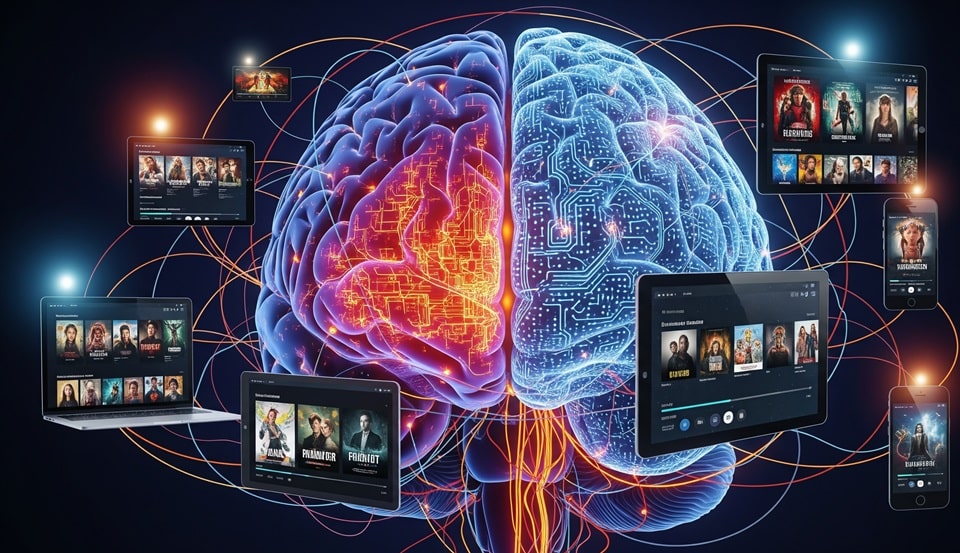Best PGDM Colleges in Bangalore | Top 10 PGDM Colleges in Bangalore
Mind Games & Masala: How OTT Platforms Hack Your Brain with Neuromarketing

If you think you have free will when choosing what to binge-watch on an OTT platform, we’ve got news for you. You don’t. That choice was strategically implanted in your head with a cocktail of neuroscience and cunning algorithms. Welcome to neuromarketing, where marketers don’t ask you what you want—they just scan your brainwaves and tell you what you’re going to want.
Yes, it’s as creepy (and cool) as it sounds. And it’s happening right here in India—especially in Bangalore, where coffee-fueled coders and psychology students are decoding your digital desires, one dopamine spike at a time.
What is Neuromarketing ?
Neuromarketing can be understood as the intersection of neuroscience and consumer behavior analysis. It utilizes advanced tools to observe and measure:
- Eye-tracking movements to assess visual attention
- Facial expression analysis to detect emotional responses
- Electroencephalography (EEG) to monitor brainwave activity
- Biometric signals like heart rate and skin conductance to gauge physiological arousal
…all aimed at uncovering subconscious preferences and decision-making patterns and to figure out what makes you feel. And feelings, dear reader, are the currency of the OTT world.
Instead of running surveys that ask “Did you like that show?”, OTT platforms go full sci-fi and use tools like:
- EEG (electroencephalography) to track brain activity.
- Galvanic Skin Response (sweat detection to measure excitement—gross but effective).
- Facial Coding Software to detect micro-expressions (you know, that brief smirk when the villain enters).
- Eye-tracking to see what visual elements draw attention.
If you react with a start during a suspenseful scene or feel emotionally moved during a poignant cinematic moment, neuromarketing technologies are silently capturing and interpreting those responses.
For example lets see how OTT Platforms Like Netflix & Prime Use It (and You)
Let’s break down their tactics. You’re not just a viewer. You’re a live data point. And they’re watching you watch.
- Click Me If You Can: The Smart Science of Thumbnails
Netflix runs A/B/C/Z testing on show thumbnails. For example:
- One viewer sees a smiling couple (romantic angle).
- Another gets a gritty action shot from the same
- A third sees a mysterious object (ooo intrigue!).
Whoever clicks more = winner. Over time, these images change based on geography, age, gender, even your watch time. It’s not the show that changed—it’s the packaging.
- Mood-Based Curation
Amazon Prime Video has embraced affective computing—a sleek tech term for systems that try to decode your mood from your clicks, watch history, and viewing duration.
In simpler terms: if you’ve been binging on emotional dramas or slice-of-life comedies, your homepage might start pushing more “feel-good” content like Panchayat, Gullak, or even a modern reboot of Kyunki Saas Bhi Kabhi Bahu thi.
Netflix, too, leans into your emotional state. Watch something dark and intense like Delhi Crime? Your next recommendation might be Mandala Murders—not because both are crime thrillers, but because both tap into that same psychological itch for justice, mystery, and morally grey characters in dimly lit interrogation rooms.
The platform isn’t just sorting by genre anymore—it’s sorting by emotional wavelength. Whether you’re craving high-stakes tension, nostalgic sobbing, or melodramatic courtroom monologues, it already knows. And it’s waiting.
- Trailer Tricks: Keeping You Hooked in 90 Seconds
Trailers today aren’t just edited with creativity—they’re fine-tuned using brain data. In some media labs, experts actually track when viewers lose interest. If people start zoning out at 0:45, that part is snipped out.
The result? Perfect 90-second dopamine hits—trailers that grab you, shake you, and make you hit “Play Now” before you even realize it.
Take The Family Man, for example. For younger audiences, the trailer was edited to highlight action scenes, witty one-liners, and Manoj Bajpayee being the coolest middle-class spy ever. But for older viewers, versions with more focus on family drama, patriotism, and tension were tested.
OTT platforms know: a college student in Bangalore and a working parent in Bhopal may need different emotional hooks—even for the same show. So trailers change based on age, mood, and region. Because in the world of neuromarketing, it’s not just about what the show is—it’s about what makes you click.
Neuromarketing, Indian-Style: Curry, Culture, and Clicks
India isn’t just a market—it’s 28 states of emotional chaos, 22 official languages, and a billion content preferences.
OTT platforms use region-specific neuromarketing strategies like:
- Vernacular tagging: Prime Video recommends Marathi comedies to a user in Pune and Bengali thrillers in Kolkata—even if they never asked for it.
- Visual bias testing: In Chennai, a poster with Rajinikanth’s the ‘Thalaiva’, side profile converts better than his frontal shot.
- Cultural triggers: Background score experiments show Indian viewers emotionally respond more to tabla beats and flute interludes than orchestral build-ups.
Even subtitles aren’t spared. A show might use more Hinglish in subtitles for Delhiites and switch to proper Hindi for other audiences.
Bangalore: Where Tech Meets Temples and Brainwaves
While most cities are busy binge-watching, Bangalore is quietly trying to understand why we binge. According to research highlighted by Wittenborg University, neuromarketing techniques like EEG headsets, eye-tracking, and biometric analysis are increasingly being used to study how Gen Z responds to digital content—especially video formats, trailers, and online ads.
As per Wittenborg’s article “Exploring Neuromarketing’s Impact on YouTube Advertising for Generation Z”, younger audiences tend to engage more with fast-paced, emotionally stimulating content, often preferring dynamic visuals, quick edits, and music with a strong beat.
Ethical Dilemma: Innovation or Emotional Manipulation?
Here’s the spicy part.
While neuromarketing creates better content discovery, there’s also this nagging question:
Is this still art… or just algorithmic manipulation?
Are you watching Panchayat because you wanted to—or because your behavioral pattern suggested you were due for a dose of rural wholesomeness after too much urban drama?
Some critics call it “emotion surveillance.” Others say it’s the future of personalized storytelling.
Final Episode (A.K.A. Conclusion)
Dear reader, the next time your OTT app seems to know you better than your best friend—it’s because it actually does.
So next time you hit “Play,” remember: It’s not just the show watching you… it’s the algorithm too. So go ahead—binge responsibly. But remember: the brain you’re using to watch that show? Someone else may already be watching it.
Disclaimer: The examples and interpretations shared in this article are based on publicly available information and general user experience. They do not reflect any proprietary data or confidential insights from the mentioned companies.
Written by:
Ms. Reena Sekharan,
Final Year PGDM Student of ABBS School of Management
Mentored by:
Dr. Kamini Dhruva,
Professor, ABBS School of Management


